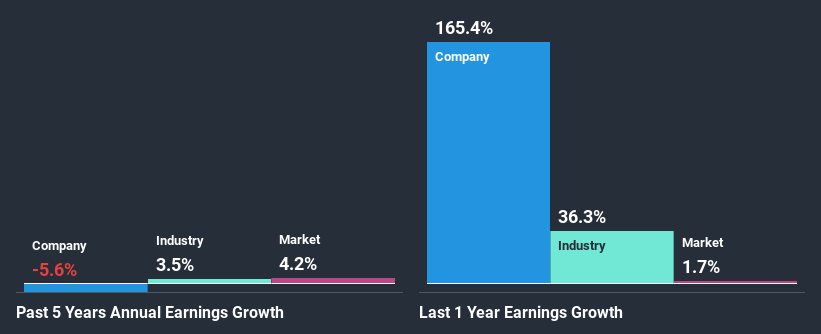- South Korea
- /
- Food
- /
- KOSE:A002140
Should Weakness in Korea Industrial Co., Ltd.'s (KRX:002140) Stock Be Seen As A Sign That Market Will Correct The Share Price Given Decent Financials?

It is hard to get excited after looking at Korea Industrial's (KRX:002140) recent performance, when its stock has declined 15% over the past month. But if you pay close attention, you might find that its key financial indicators look quite decent, which could mean that the stock could potentially rise in the long-term given how markets usually reward more resilient long-term fundamentals. Particularly, we will be paying attention to Korea Industrial's ROE today.
Return on Equity or ROE is a test of how effectively a company is growing its value and managing investors’ money. Put another way, it reveals the company's success at turning shareholder investments into profits.
View our latest analysis for Korea Industrial
How To Calculate Return On Equity?
ROE can be calculated by using the formula:
Return on Equity = Net Profit (from continuing operations) ÷ Shareholders' Equity
So, based on the above formula, the ROE for Korea Industrial is:
8.0% = ₩8.1b ÷ ₩101b (Based on the trailing twelve months to September 2020).
The 'return' refers to a company's earnings over the last year. That means that for every ₩1 worth of shareholders' equity, the company generated ₩0.08 in profit.
What Has ROE Got To Do With Earnings Growth?
So far, we've learned that ROE is a measure of a company's profitability. We now need to evaluate how much profit the company reinvests or "retains" for future growth which then gives us an idea about the growth potential of the company. Assuming everything else remains unchanged, the higher the ROE and profit retention, the higher the growth rate of a company compared to companies that don't necessarily bear these characteristics.
Korea Industrial's Earnings Growth And 8.0% ROE
At first glance, Korea Industrial's ROE doesn't look very promising. Although a closer study shows that the company's ROE is higher than the industry average of 6.5% which we definitely can't overlook. However, Korea Industrial's five year net income decline rate was 5.6%. Bear in mind, the company does have a slightly low ROE. It is just that the industry ROE is lower. Therefore, the decline in earnings could also be the result of this.
However, when we compared Korea Industrial's growth with the industry we found that while the company's earnings have been shrinking, the industry has seen an earnings growth of 3.5% in the same period. This is quite worrisome.

Earnings growth is an important metric to consider when valuing a stock. The investor should try to establish if the expected growth or decline in earnings, whichever the case may be, is priced in. Doing so will help them establish if the stock's future looks promising or ominous. One good indicator of expected earnings growth is the P/E ratio which determines the price the market is willing to pay for a stock based on its earnings prospects. So, you may want to check if Korea Industrial is trading on a high P/E or a low P/E, relative to its industry.
Is Korea Industrial Efficiently Re-investing Its Profits?
Korea Industrial's low three-year median payout ratio of 12% (implying that it retains the remaining 88% of its profits) comes as a surprise when you pair it with the shrinking earnings. The low payout should mean that the company is retaining most of its earnings and consequently, should see some growth. It looks like there might be some other reasons to explain the lack in that respect. For example, the business could be in decline.
In addition, Korea Industrial only recently started paying a dividend so the management probably decided the shareholders prefer dividends even though earnings have been shrinking.
Summary
On the whole, we do feel that Korea Industrial has some positive attributes. Although, we are disappointed to see a lack of growth in earnings even in spite of a moderate ROE and and a high reinvestment rate. We believe that there might be some outside factors that could be having a negative impact on the business. While we won't completely dismiss the company, what we would do, is try to ascertain how risky the business is to make a more informed decision around the company. You can see the 4 risks we have identified for Korea Industrial by visiting our risks dashboard for free on our platform here.
If you decide to trade Korea Industrial, use the lowest-cost* platform that is rated #1 Overall by Barron’s, Interactive Brokers. Trade stocks, options, futures, forex, bonds and funds on 135 markets, all from a single integrated account. Promoted
Valuation is complex, but we're here to simplify it.
Discover if Korea Industrial might be undervalued or overvalued with our detailed analysis, featuring fair value estimates, potential risks, dividends, insider trades, and its financial condition.
Access Free AnalysisThis article by Simply Wall St is general in nature. It does not constitute a recommendation to buy or sell any stock, and does not take account of your objectives, or your financial situation. We aim to bring you long-term focused analysis driven by fundamental data. Note that our analysis may not factor in the latest price-sensitive company announcements or qualitative material. Simply Wall St has no position in any stocks mentioned.
*Interactive Brokers Rated Lowest Cost Broker by StockBrokers.com Annual Online Review 2020
Have feedback on this article? Concerned about the content? Get in touch with us directly. Alternatively, email editorial-team (at) simplywallst.com.
About KOSE:A002140
Korea Industrial
Manufactures and sells mixed feed for laying hen, broiler, pig, dairy, feeder cattle, duck, rabbit, black goat, sheep dog, and others in South Korea.
Proven track record low.
Market Insights
Community Narratives



